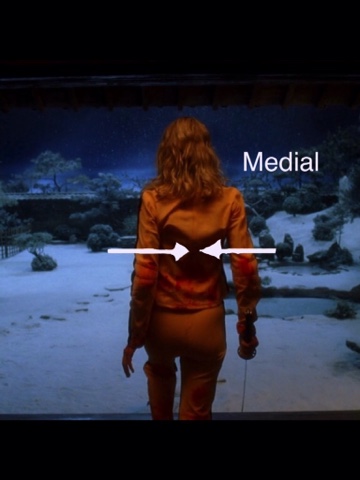The picture above displays the anatomical position. This position requires an erect body, palms and face directed forward. This position is very common in anatomy, as it easily shows correlation between the parts of the body.
The next picture demonstrates body directions in regards to what is located above/below another body part while the body is in anatomical position. These directions are known as "Superior" and "Inferior". For an example, the head is superior to the waist while the feet are inferior to the knees.
This next picture also demonstrates direction, though this focuses more on "in front" or "behind". In anatomy, this is referred to as "Anterior" and "Posterior". The navel is anterior to the spine, and the spine is posterior to the navel.
The next two images featured below illustrate two different body directions. Medial refers to body parts located toward the midline of the body while lateral refers to body parts located away from the midline of the body. The spine is medial to the shoulders while the shoulders are lateral to the spine.
Due to the mobility of appendages, there are specific directions to classify what is close/far relative to the body. The farther something gets from the trunk is described as distal while the closer something is to the trunk is described as proximal. The fingers are distal to the elbow, and the shoulder is proximal to the wrist.
The last directional terms we are going to discuss are superficial and deep. These reference how close something is to the surface of the body. The spine is deeper than the skin, and the skin is more superficial than your skeleton.
Newt, we are going to go over the planes of the body. The Saggital Plane divides the "left" and "right" sides of the body.
The Transverse Plane divides the body into superior and inferior sections.
The Frontal Plane separates anterior from posterior.
The body also has many cavities, or spaces that have the potential to be hollow. The picture below shows many of these cavities. You can even go to a smaller scale than that shown, for example, the nasal cavities, orbital cavities, etc.
Another think to look at are membranes, specifically those surrounding the heart, which are illustrated in the picture below. The visceral pericardium membrane directly covers the heart, with the parietal pericardium membrane on the outer side. The pericardial cavity divides the two, which is filled with biological fluids.
The last thing we are going to discuss in this post is the regions of the core/trunk. There are nine of these regions. They help organize the abdomen and the parts of the body associated with it.
There you have it-the basic ways to organize the human body!













No comments:
Post a Comment